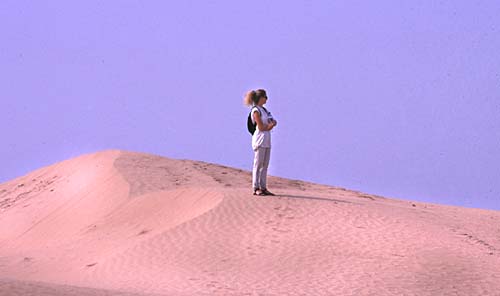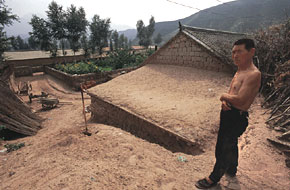-----------------------------
According to a BBC News report: "A senior Chinese official has said it will take 300 years to turn back China's advancing deserts at the current rate of progress.
 ..More than one quarter of China is either covered by desert or is land that is suffering desertification.
..More than one quarter of China is either covered by desert or is land that is suffering desertification.The process is often caused by overgrazing and other unsuitable farming techniques."
Leading China's efforts to tackle the problem, Liu Tuo said the investment for the endeavor was "seriously insufficient."
 He added: "There is about 1.73m sq km (0.67m sq miles) of desertified land in China, and about 530,000 sq km of that can be treated," he said.
He added: "There is about 1.73m sq km (0.67m sq miles) of desertified land in China, and about 530,000 sq km of that can be treated," he said."At our present rate of treating 1,717 sq km a year, I've just calculated we'll need 300 years."
Another report states:
"The desert is sweeping into China's valleys, choking rivers and consuming precious farm land. ..The Great Green Walls may not be able to buffer the sand, which could cover the capital in a few years."
With a population of over 1.3 billion, China's fertile land is a crucial resource. Such is the enormity of their problem of desertification on the fringes of the Gobi Desert which lies in the west of the country.
 Here under the third - ETC Chapter, as a continuation of earlier post - "ECoPaD - Landsteading"
Here under the third - ETC Chapter, as a continuation of earlier post - "ECoPaD - Landsteading"-------------------------------------------------------------------------------------------
I think an area like Gobi desert is a candidate example for Land steading.
What if somehow, seawater from east Chinas sea is pumped in an artificial aquifer to be located in this desert?
What if inland salt water aquaculture is tried here?
I think we all know, such effort if made successful will help feed their growing population, provide employment and arrest desertification.
With "Modular Auxiliarity" and "ECoPaD" applied, I believe, it can be done.
Tubes and cylinders:
Tubes and cylinder-like shapes are prevalent among the packages on the market. Canned goods, drinks in Polyethylene bottles and even the flexible computer keyboard, I bought yesterday was delivered in cylinder plastic form.
With coordinated diameters and sizes, these packaging materials destined for landfills can be connected and conveniently used for so many purposes.
 Here is one possible way of interconnecting them to serve a secondary purpose:
Here is one possible way of interconnecting them to serve a secondary purpose:Tin cans will provide strength while plastic containers both inside and outside can provide rust proofing and the interconnection functions.
Hose or other similar materials can also be connected, especially when curving to avoid certain obstacles.
They can be connected into a long pole and fortified inside with cement, recycled iron bars etc.
If the material is to be used as framing for some furniture, dried coco-leaves or twigs can also be used together with some glue (animal glue, lignin or the ones used for paper mache).
I can name many uses for rigid tubes/cylinders, but for now, we'll just say, they can be used for bringing sea-water inland. Standardization and diameter ratings will be helpful for encouraging and sorting these clutter.
Bricks:
We have previously tackled some possible ways of creating confluent uses for boxlike packages and how they can be interlocked.
Let's clarify that although our example presented previously are the tetra pak items, box-like packages can come in other materials. They are all usable for building purposes.
Also, to provide rigidity, we are not limited to using earth, sand, cement mixtures.
They can be filled with discarded printer cartridges, plastic caps, styropor and such commonly disposed consumer packages. Metals or such items can be wrapped in discarded plastic bags for longer life, if they are mixed with soil.
Artificial Aquifer:
Now, for making the Artificial Aquifer, we have to use non-corrosive box-like packages. They can be filled with various types of materials that experts may recommend for desalination. An artificial lake with various stages of gravity filtration can be dug up in the Gobi desert.
The walls can have layers consisting of bricks filled with desert sand, ceramic granules, coal/activated carbon and other materials. As a result, from the initial unfiltered compartment, some others will fill with water of different levels of salinity which may be good for certain species of fish or particular water plants.
Clutter Buster:
But first, Clutter Buster collection centers have to be constructed on the edge of the desert.
To aid the fight against desertification, desert sand can be used to fill them up into bricks. The centers themselves can be constructed using the bricks from re-purposed packaging materials.
For stacking the filter bricks, this arrangement can be made:

 Strong wires can be used to hold the bricks together.
Strong wires can be used to hold the bricks together.The bricks can be temporarily piled up as to be shaped into a mound.
 The mound will be layered with thin plywood and then the bricks will be stacked tightly with wires and cemented above the mound.
The mound will be layered with thin plywood and then the bricks will be stacked tightly with wires and cemented above the mound. After the cement hardens, the bricks piled temporarily inside, will be removed and the process can be repeated to make an ever-expanding facility, that is limited only by the supply of desert sand and the discarded box containers. The sides can be fortified further by laying some used tires outside filed with sand/cement mix.
Here is how it may look:

Using the same procedures, facilities such as school, housing and transportation tunnel can be made up to the location of the inland lake/aquifer site.
The desert sands can be turned into a product for desert and sea reclamation, thus communities can slowly flourish.
The Gobi desert can be repopulated by mangroves, crabs and such other species turning it into a man made marsh eco-system. A planned city can be made, complete with a physical internet with sea water as the delivery system using tubes.
Senator Ted Stevens will be glad.
The tires stacked up on the sides of the buildings can also accommodate soil/sand mix for tree planting.
ReplyDeleteThis way, when the trees take root, it will serve as natural barrier and fortification - not to mention shades and natural beauty.
Also, the desert sand can be rich in silicon so that facilities may used them for making solar panels.
ReplyDeleteAnd the same can be mounted on top of the elongated domes for harnessing power from the sun.
Rest in peace, Senator Ted, you were technically close to giving a layman a description of internet.
ReplyDeleteThe internet can really be explained as "virtual" tubes via which "digital packets" zip and assemble into files and records at the computer terminals.